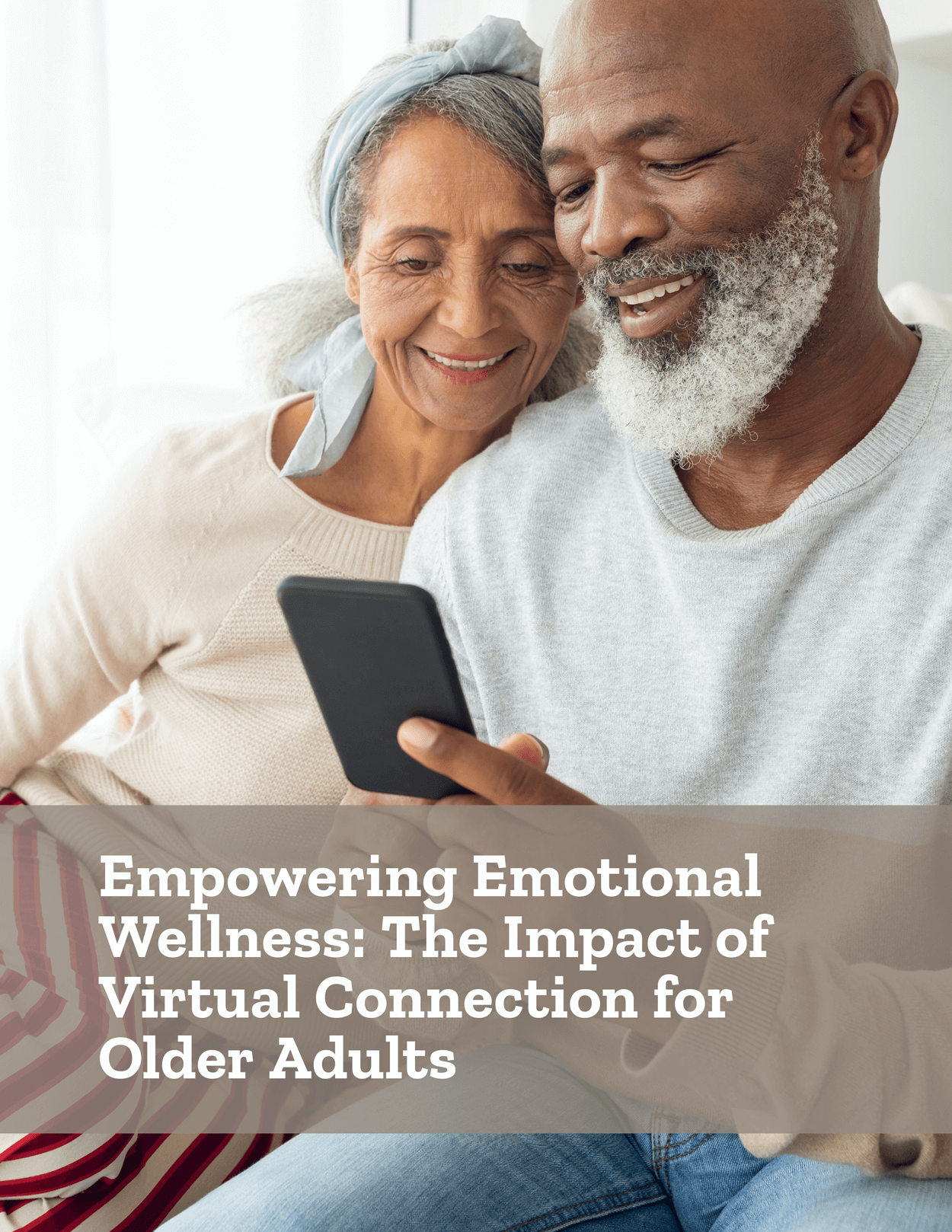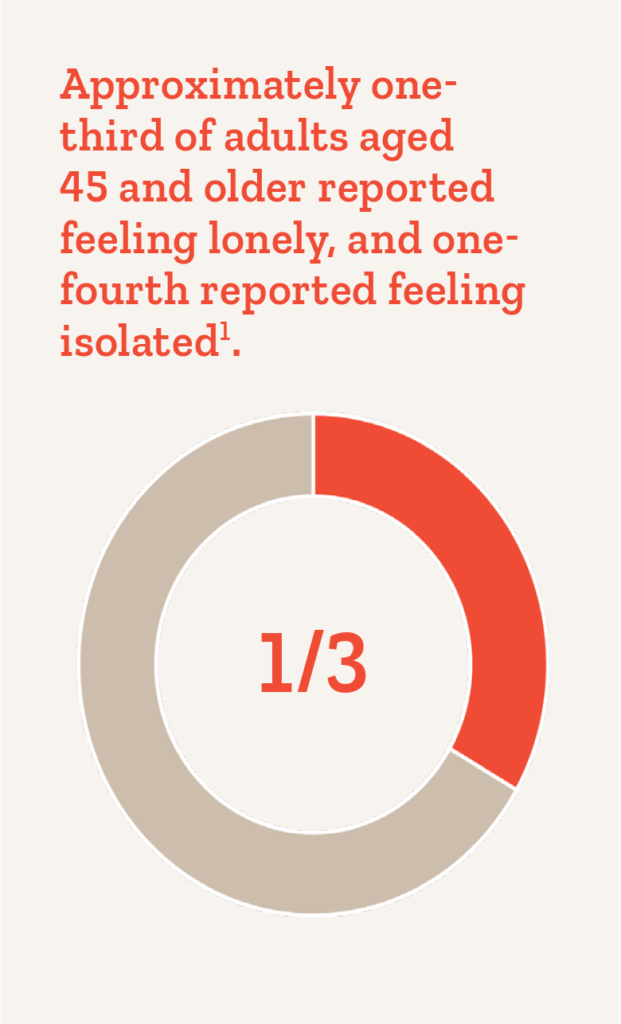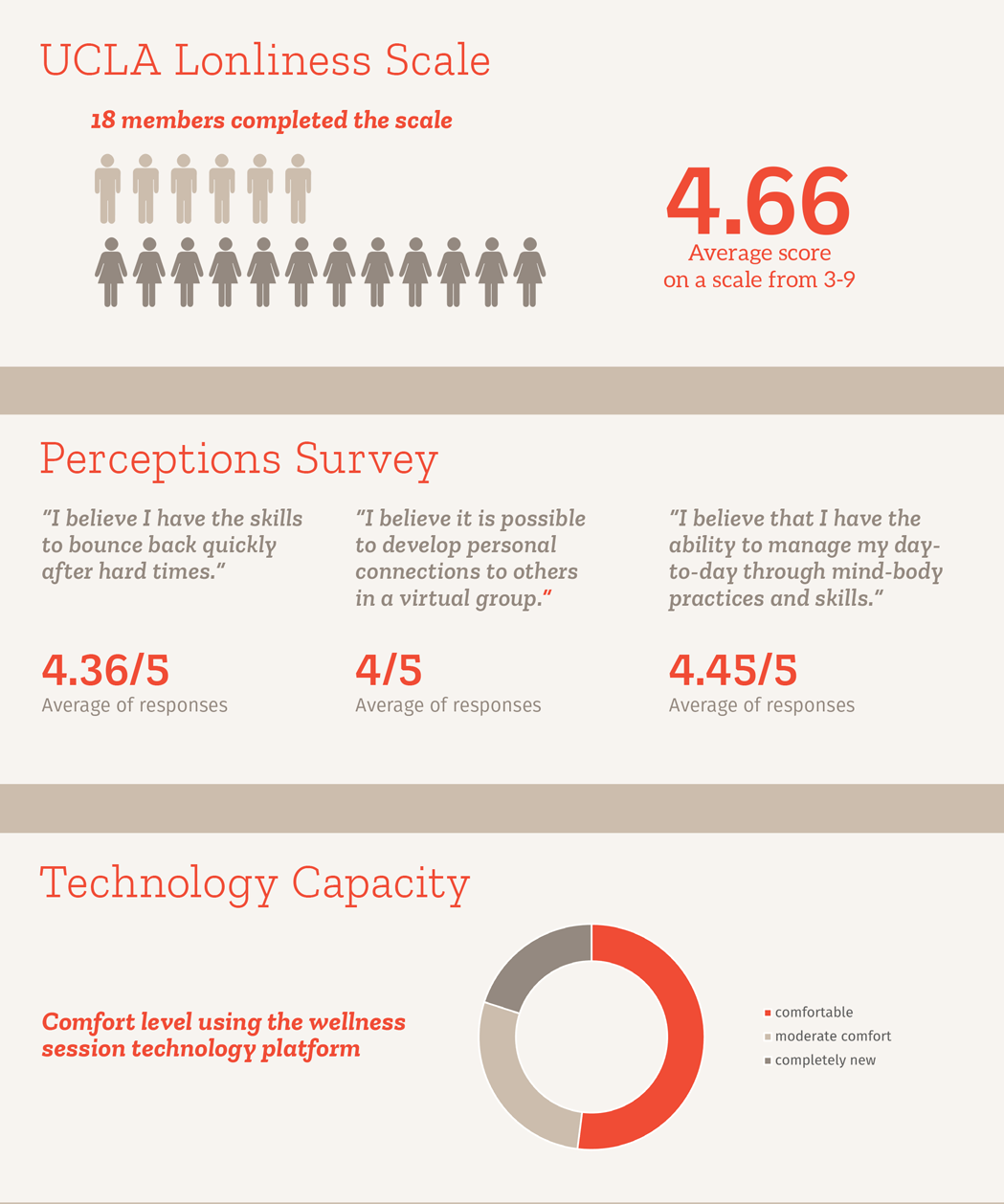
Executive Summary
The use of virtual wellness and support groups has become increasingly popular as a means of combating loneliness in older adults. Virtual groups provide a meaningful way for older adults to connect with others and build social connections.
This tool can be especially effective for those that are homebound or have limited mobility. Research has shown that virtual groups can help older adults reduce feelings of loneliness, facilitate connections with others experiencing similar challenges, and provide a space to learn skills around maintaining mental and emotional well-being, even in the face of physical isolation.
Vita Valens developed the following research project to gain insight into how virtual groups can be employed to support older adults in New York City. In this white paper, Vita Valens examines the efficacy and barriers to teaching mindfulness techniques in a virtual group setting and the impact virtual wellness groups can have on the emotional and physical well-being of older New Yorkers. Through its implementation research efforts, Vita Valens recruited a cohort of older adults in and around NYC to participate in a 9-week clinician-led wellness group. The virtual groups employ and teach mindfulness techniques to address self-limiting beliefs and strengthen resiliency and mind-body practices.
This white paper shares how virtual groups can have a positive impact on self-reported loneliness and perceptions of whether relationships can be built through virtual groups. We discuss the benefits of using virtual rooms to form real connections with older adults, the challenges that may arise, strategies for overcoming those challenges and key learnings from our current cohort to date.

Background
Loneliness is a growing epidemic that affects people of all ages, but it is particularly prevalent among older adults. According to a study by the AARP, approximately one-third of adults aged 45 and older reported feeling lonely, and one-fourth reported feeling isolated1 . Loneliness and self-limiting beliefs can have serious physical and emotional health consequences. Studies have found that loneliness is associated with a higher risk of cardiovascular disease, cognitive decline, depression, and anxiety. It can also lead to a decreased immune function, increased inflammation, and a higher risk of mortality1 .
To combat loneliness, it is important to prioritize social connection, invest in building and maintaining relationships with others, and to create inclusive and supportive environments where everyone feels valued and connected. Virtual groups provide older adults with the opportunity for growth, engagement and learning to maintain their physical and emotional well-being and enjoy a high quality of life.

Methodology
An initial cohort of 24 New Yorkers, aged 60 years and older, was identified through outreach by the Vita Valens’ Engagement Team utilizing existing databases. Individuals were contacted telephonically, invited to participate, and then enrolled in real time. The outreach and enrollment period took two weeks. Once the initial cohort was formed, Engagement Specialists conducted outreach to participants to provide a technology demonstration and review, complete a loneliness baseline assessment, and review participation information and guidelines.
The first session of the 8-week interactive wellness group began on March 16, 2023. The wellness group sessions focus on a range of skills and topics around gratitude, self-care and self-compassion, and other mind-body and resilience techniques. Examples of skills learned, practiced, and developed though the group sessions include but are not limited to: 1) Stress management; 2) Strategies and practices that can improve quality of life and overall health; 3) Maintaining positive relationships and developing meaningful connection; 4) Application of mind and body principles needed to rest and recharge when life gets overwhelming; 5) Understanding and listening to emotions and making decisions aligned with a person values and intentions; 6) Identifying, challenging, and reframing the narrative to one that empowers the person.
The 8-week course was designed to create a supportive environment where older adults in and around NYC can create meaningful connections with peers and learn how to navigate their current lives with grace for themselves and others.
The Vita Valens Engagement Team used multiple tools to collect data on several key areas of interest for this research project. The Three-Item UCLA Loneliness Scale was employed to determine a self-reported loneliness score for all participants prior to and following the intervention2 . The second tool was developed by the Vita Valens team to gain insight into participant perceptions of (1) resiliency, (2) forming connections through virtual platforms and (3) ability to manage day-to-day through learning mind-body practices and skills. The perception survey includes three questions and uses a Likert scale of Strongly Disagree to Strongly Agree. Finally, data on ease and use of technology was collected. Participants were asked about their comfort level using a virtual meeting platform, the type of device available, and if they would like to attend an individual teaching session to practice using their virtual room technology.

Initial Cohort Enrolled
An initial cohort of 24 New Yorkers, aged 60 years and older, was identified and enrolled in the study

Group Sessions
Sessions focus on a range of self-care skills and topics and resilience techniques.

Data Collection
Data on lonliness, participant perception and use of technology were collected.

Focus
The 8-week course was designed to create a supportive environment for older adults.
Initial Findings and Observations
Of the 24 individuals identified the following data was collected prior to the initial group session:
UCLA Loneliness Scale
18 members of the cohort completed the Loneliness Scale
- 6 self-identified as men
- 12 self-identified as women
- The cohort participants were from a diverse geographic, racial, household structure, and socioeconomic backgrounds
6 members of the cohort did not complete the Loneliness Scale
- 2 individuals decided they did not want to join this cohort but were interested in future groups
- 2 individuals were unreachable
- 2 individuals decided they no longer wanted to attend the group
Results from the 18 individuals that completed the scale
- Average score at baseline was 4.66
- Self reported scores ranged from 3 to 9
UCLA Loneliness Scale
|
Score |
3 |
4 |
5 |
6 |
7 |
8 |
9 |
|---|---|---|---|---|---|---|---|
|
Number of |
8 |
2 |
1 |
4 |
2 |
0 |
1 |
Scale reflects ranges from 3 (least lonely) to 9 (most lonely)
Perceptions Survey
11 participants completed the perceptions survey. The baseline results to statements read were as follows:
“I believe I have the skills to bounce back quickly after hard times.”
Average of responses was 4.36/5
“I believe it is possible to develop personal connections to others in a virtual group.”
Average of responses was 4/5
“I believe that I have the ability to manage my day-to-day through mind-body practices and skills.”
Average of responses was 4.45/5

Technology Capacity
24 participants answered technology capacity questionnaire.
Comfort level using the wellness session technology platform:
- 13 self-reported comfort using virtual platform
- 7 self-reported moderate comfort virtual platform
- 5 were completely new to virtual platform
Technology demonstration:
- 5 individuals scheduled a demonstration session
Five individuals discontinued participation after the initial group session. Self-identified barriers and reasons for discontinuing after initial attendance:
- 1 participant was not able to continue attending due to device issues.
- 2 participants discontinued citing the need for a more psychological group therapy
- 2 participants wanted to attend but their work schedule did not allow it.
Key takeaways from the group session. The group sessions were well received, attended, and had active participation. None of the participants that were new to the virtual platform attended any of the wellness sessions. 10/11 of the cohort members that completed the perceptions survey attended at least one group session. Attendance ranged from four to nine individuals per week with a median attendance of six. The first three weeks of the group had at least one male participant with the highest week having two male participants. The last four weeks had one male in attendance for one session. Attendance has been predominantly female throughout all the weeks. People were welcomed into the group in the same manner regardless of what week they joined and all participants were given the same opportunity to share and interact during the sessions they attended.
|
Score |
3 |
4 |
5 |
6 |
7 |
8 |
9 |
|---|---|---|---|---|---|---|---|
|
Number of |
8 |
2 |
1 |
4 |
2 |
0 |
1 |
Scale reflects ranges from 3 (least lonely) to 9 (most lonely)
Perceptions Survey
11 participants completed the perceptions survey. The baseline results to statements read were as follows:
“I believe I have the skills to bounce back quickly after hard times.”
Average of responses was 4.36/5
“I believe it is possible to develop personal connections to others in a virtual group.”
Average of responses was 4/5
“I believe that I have the ability to manage my day-to-day through mind-body practices and skills.”
Average of responses was 4.45/5

Conclusion and Next Steps
Virtual rooms can be a useful tool for promoting emotional wellbeing among older adults. Providing older adults with a platform to connect with others, access emotional health resources, and learn new self-care skills can help combat the isolation and loneliness. Virtual platforms can also provide a sense of community, shared experience and support for older adults who are learning mind-body techniques. Practicing new techniques and skills virtually can also support peer-to-peer encouragement and learning.
While there are many benefits to the virtual modality, there are also challenges regarding participant technological literacy and technology failures. These challenges were overcome with active support from the Vita Valens team prior to and during the group session. Platform audio and visual challenges were overcome through virtual and phone assistance to provide individual coaching and troubleshooting techniques. Inconsistent bandwidth and device failure were not able to be addressed during the sessions.
It is also notable from the results that virtual spaces are not accessible for all individuals. Individuals without some prior knowledge of the virtual platform did not attend despite efforts to provide education and support. Additionally, some adults prefer in-person connections and discomfort with virtual connections may also pose as a barrier to participation. Understanding this, it is important that services be offered in a range of modalities including virtual and in-person options.
Additional studies are needed to investigate the gender differences identified through this initial project. Potential future studies may include conducting groups separated by gender and considering varying staff genders to create a more representative and inclusive environment. Further research is needed to better understand why male participants were more likely to stop attending group sessions than female participants, and how to engage all participants regardless of gender.








